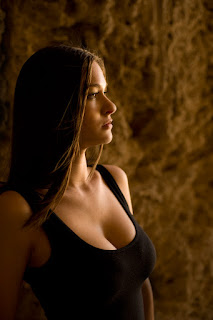Achieving a memorable portrait is far more about the quality of lighting and communicating with your subject than it is about camera settings. Visualising the end result and choosing the right location are important factors. However, at the basis of a ll great portraits is genuinely liking your subject. The great English portrait photographer said he often fell in lobe with his subject during the portrait sitting.
1.
Use telephoto in preference to wide-angle
A telephoto lens brings the subject closer but does something more important – the longer focal length flattens perspective and keeps the shape of the face in correct proportion. A telephoto lens avoids the ‘I’ve just been to the dentist’ look!
 |
| Eugenie Ong |
2.
Keep lens above subject’s nose height
If there’s one thing that’s likely to upset your subject it’s a double-chin. Keeping your lens height higher than the subject’s nose reduces the risk. And reduces hours of Photo shopping.
3. Subject-background distance greater than subject-camera distance
An out-of-focus background usually enhances portraits. One simple technique is to keep the background a long way away and the subject close.
4. Focus on the eyes
There’s one part of a portrait that just has to be as sharp as a surgeon’s scalpel – the subject’s eyes (both of them!). The eyes aren’t just the ‘windows to the soul’ they are first point of contact for the viewer.
5.
Kids – get down to kid’s level physically and mentally
Typically, parents and grandparents start off by doing the ‘ogre’ shots – standing directly above the baby. Photographers should become children themselves – shoot from their level physically and think like a child when shooting them at play.
6.
Shoot for a black and white image
There’s a saying, ‘Shoot in colour and you photograph the subject’s clothes, photograph in black and white and you photograph the subject’s soul.’ Technically, it’s best to shoot in colour and convert in your computer.
7.
Choose a great background
A great background makes your subject the ‘star’; makes your subject shine in the frame. Backgrounds that are overly sharp or bright with strong lines and angles should generally be avoided. Dark blurred recesses and open doorways are often useful backgrounds.
8. Become a student of light and use ‘Rembrandt’ lighting
The word ‘Photograph’ comes from the Greek meaning writing or painting with light. Using a light source at ninety degrees to the subject’s face adds drama and modeling. Window light is the easiest quality light to use.
9. Get couples/groups to interact with each other rather than you
The linkages between the couple or members of the group should be far closer than the linkages with the photographer. Ask your subjects to chat and interact with each other. Your task as a portrait photographer is to record the emotional bonds.
10. Photograph your subject with their most treasured item
An individual, no matter whether adult or child will often feel more comfortable with their most treasured item – their guitar, cat, dog or football.
 |
Indian Tsunami
WAPPA - Award winning image 2005 |
11. Use Auto-Bracket
The ‘Auto-bracket’ setting on your camera gives you sequence of different exposures in quick succession. Auto-bracketing overcomes many of the problems of blinking and odd expressions.
12. Create an Environmental Portrait
Choose a ‘Landscape’ aspect ratio, place your subject in a position of power and use the subject’s favourite room, workspace or outdoors on each side of your subject to help tell the story of your subject.
If you have a special portrait and you'd like to win $5000 cash enter the
Fremantle Portrait Prize before 1 August 2012.
 The second major factor is
the actual focal length of the lens. A photographer needs to be sufficiently close to their subject to communicate without
shouting but not so close that hey encroach on the subject’s personal space. Of equal importance is subject-lens distance. if you get too close to your subject you will steepen
perspective and distort facial features. Few subjects, other than circus clowns would appreciate this!
The second major factor is
the actual focal length of the lens. A photographer needs to be sufficiently close to their subject to communicate without
shouting but not so close that hey encroach on the subject’s personal space. Of equal importance is subject-lens distance. if you get too close to your subject you will steepen
perspective and distort facial features. Few subjects, other than circus clowns would appreciate this!









.jpg)

.jpg)


.jpg)
.jpg)

